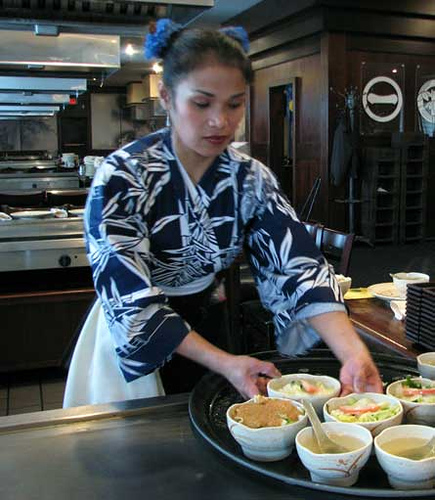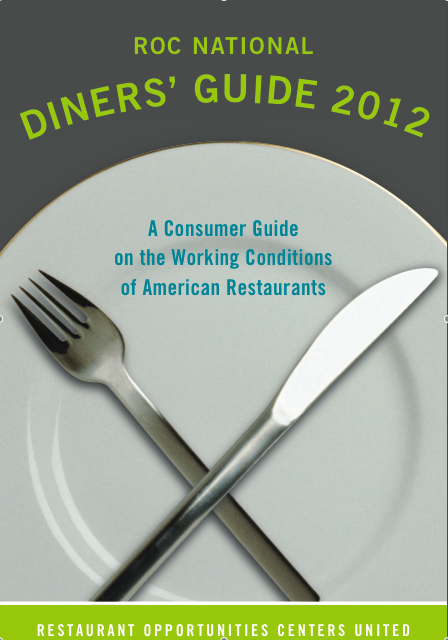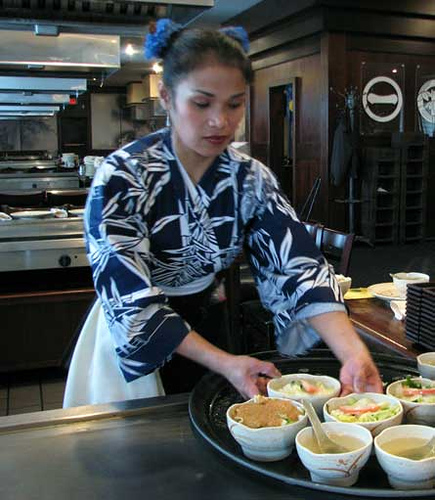 Photo: Bravo123Restaurants know their customers worry over the source of an heirloom tomato, or the care with which their pork was raised and handled. But when it comes to the treatment of the person who prepared it, few establishments make it a point to be transparent.
Photo: Bravo123Restaurants know their customers worry over the source of an heirloom tomato, or the care with which their pork was raised and handled. But when it comes to the treatment of the person who prepared it, few establishments make it a point to be transparent.
Now, there’s a guide for that. For the first time, an organization called the Restaurant Opportunities Center (ROC) has released a Diners’ Guide that rates the 150 highest-grossing restaurants in the country on criteria like living wages, paid sick leave, and opportunity for career advancement. The goal, says ROC, a coalition of restaurant workers with 9,000 members in nine U.S. cities, is to empower eaters to help move the industry toward change.
“The question we always get is, ‘Where should we eat; what can we do as consumers to support workers?'” says Saru Jayaraman, ROC’s co-director. “We’d heard it so much, we decided we had to do something about it.”
ROC collaborated with students from Tulane University and University of California, Los Angeles to investigate the labor practices of the country’s biggest restaurants. The result is a guide that says which restaurants are guilty of common industry behaviors like paying tipped workers less than $5 an hour and non-tipped workers less than $9 (the federal minimum wages for each are $2.13 and $7.25, respectively); not offering paid sick days; and denying employees a chance to be promoted.
Jayaraman holds the now ex-presidential candidate Herman Cain to blame for what she calls the “abysmal” $2.13 minimum wage. As a lobbyist for the National Restaurant Association, in 1996, Cain struck a deal with Congress agreeing that his group wouldn’t block a rising minimum wage as long as the wage floor for tipped workers stayed frozen at its 1991 level.
“What that essentially means is the industry and Congress are saying, ‘We expect you consumers to pay the wages of these workers [through tips],'” Jayaraman says. “It’s not fair to workers and it’s not fair to consumers. The industry is thriving, but tipping is not; people are not tipping as much as they used to because people are struggling.”
The median wage for the more than 10 million restaurant workers in the U.S. is $8.90 per hour. Jayaraman said only 20 percent of industry jobs pay a living wage, and restaurant workers often live in poverty or are homeless.
“One of the myths the industry likes to put out is [that] these are young workers, that it’s okay because they just transition out of this industry to something different,” Jayaraman says. And while that is the case for some restaurant workers, there are also many who will work in restaurants for their entire adult careers. “These are individuals who take great pride in their work. They don’t want to move on to ‘something better’; they want the industry to provide wages they can live on,” she says.
 Ninety percent of 4,300 restaurant workers surveyed by ROC reported not having paid sick days. In an industry with already rock-bottom wages, a missed day of work could mean the difference between making rent and being evicted. But coming to work sick, as two-thirds of surveyed employees said they had, makes the problem a public health disaster as well as a workers’ rights issue.
Ninety percent of 4,300 restaurant workers surveyed by ROC reported not having paid sick days. In an industry with already rock-bottom wages, a missed day of work could mean the difference between making rent and being evicted. But coming to work sick, as two-thirds of surveyed employees said they had, makes the problem a public health disaster as well as a workers’ rights issue.
Occupational segregation, Jayaraman said, is also a widespread, systemic problem in the industry: ROC found a $4 wage gap between white workers and workers of color, and Jayaraman pointed out how common it is to walk into a restaurant where the servers, hosts, and bartenders — the ones making the most money — are white, while bussers and kitchen staff are people of color.
“The busser will know the menu, have been there a long time, and apply for a promotion and consistently be denied because they don’t have ‘the look,'” Jayaraman explained. “They’ll be passed over [in favor of] a much less experienced person. It’s demoralizing and unjust.”
Darden Restaurants — which owns the Olive Garden, Red Lobster, Longhorn Steakhouse, and the fine-dining chain of Capital Grille steakhouses — is a particular offender in this category, the Diners Guide researchers found. In fact, ROC is helping workers pursue legal charges against those four restaurants, for discrimination and wage theft.
Being denied promotions leads to a lot of employee turnover in the industry, as workers move between restaurants looking for better opportunities, and this problem — like the lack of sick days — impacts customers, too. “What you end up with is an industry where nobody’s able to develop their craft,” Jayaraman says. “Long-term workers are able to move up; they do better and better at their job, so diners get better food and better service.”
Of course, by scrutinizing the nation’s highest-grossing restaurants, the Diners’ Guide mostly sheds light on national chains, not your favorite foodie haunt down the street. Jayaraman stressed that she sees “exploitation at all ownership levels,” but acknowledges that it’s the big companies that should come under the most pressure to change the way they operate. “These companies … make so much money off Americans, and have the power to change standards,” she says.
The Diners’ Guide is not meant simply to tell eaters where to spend their money, but also to encourage them to become advocates. Each guide comes with tear-out cards in the back that diners can hand out to restaurant workers, outlining their rights, or to employers, pointing them to ROC to learn how to improve their practices.
“Workers know this [abuse] is going on. They’re sick of it. But they’re also incredibly afraid,” Jayaraman said. “This is a bad economy, and employers have beat it into their heads that they should be grateful for their jobs. This is why we do these things, to help people stand up.”




